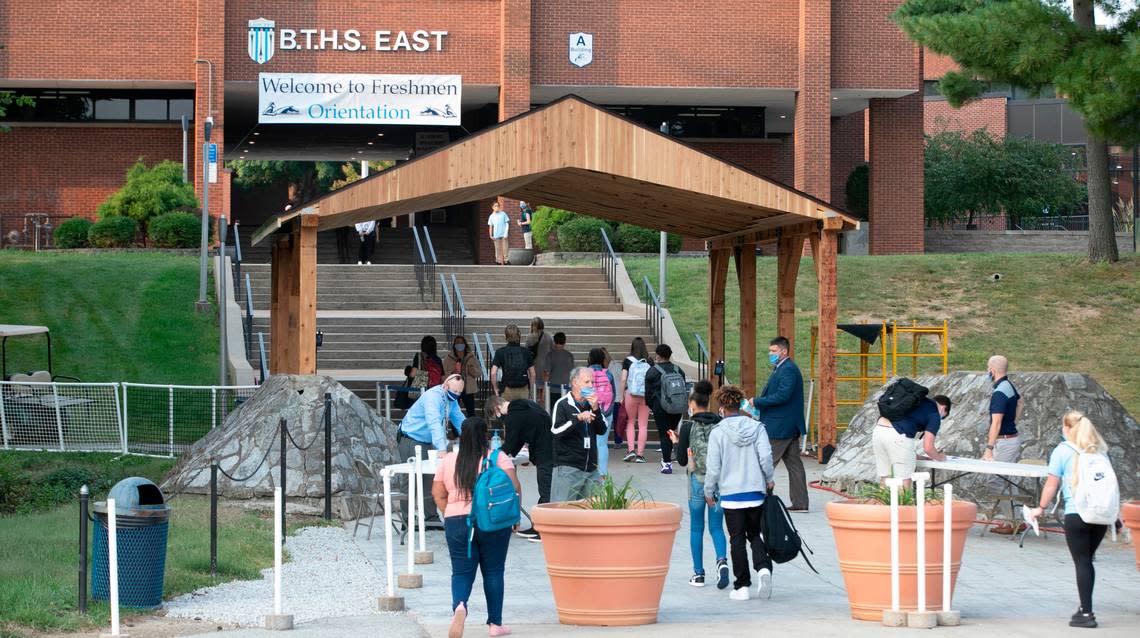Belleville 201 received millions in COVID relief funds. How has the district spent it?

Belleville Township High School District 201 was allocated more than $9 million in the third round of pandemic-era federal funding, which it has used on expenditures like building improvements and hiring more teachers to reduce class sizes.
COVID-19 disrupted education in unprecedented ways as schools in the metro-east and across the country closed and shifted to virtual instruction. To help them weather the impacts of the pandemic, Congress created the Elementary and Secondary School Emergency Relief Fund — abbreviated as ESSER — which gave $190 billion in aid to K-12 schools in three waves.
Belleville 201 was allocated about $916K in the first wave, $3.4 million in the second and $9.1 million in the third, according to the Illinois State Board of Education’s ESSER spending dashboard.
Assistant Superintendent Dustin Bilbruck said the district used the ESSER I and II dollars mostly on things like student technology, additional staff and COVID personal protective equipment that the district never had to have before, like masks, face shields, thermal scanners and electro-static disinfectant sprayers.
The third and final wave provided the largest allocation of relief funds, and legislation required school districts to solicit local input to inform their spending plans and make those plans public.
Bilbruck said the district has adhered closely to its ESSER III spending plan for its $9.1 million allocation. The district has spent about $7.3 million of its allocation and has about $1.8 remaining, according to the dashboard.
Over half of the allocation — about $4.9 million — has been used for building improvements, including heating, ventilation and air conditioning, roof work and tuckpointing. The district budgeted about $2.65 million for fiscal year 2023 and $1.5 million in 2024, and it has about $750,000 budgeted for 2025.
The district made a strategic decision to spend the largest chunk of its ESSER III funding on infrastructure work that won’t need to be done again for several years to reduce the budget impact of not having those federal dollars moving forward, Bilbruck said.
Belleville 201 was also able to pay for some staff salaries with the ESSER funding to make room elsewhere in the budget for other voluntary facility upgrades like new lighting at the performing arts centers, which won’t need to be done again for at least a decade, he said.
School districts have until Sept. 30, 2024, to obligate their ESSER III funds, and many are facing a “fiscal cliff” as the temporary infusion of additional federal funding for schools dries up. To navigate the cliff, some districts are anticipating cuts to staff and programs that can’t be sustained without ESSER.
Other one-time expenses District 201 used its ESSER III funds for include about $700,000 budgeted for the district’s one-to-one student device program — which includes new Chromebooks for incoming students and wireless hotspots for students who don’t have internet access at home — as well as about $200,000 budgeted for purchasing instructional supplies, materials and services.
Bilbruck said the district overhauled teacher presentation technology by purchasing new ViewBoards for classrooms on both campuses and the CAVE.
At the May board meeting, he also explained that the district is making some adjustments to its ESSER III grant to use about $167K to buy calculators.
The math departments at both Belleville West and East have plans to issue calculators to students in the same way they issue Chromebooks, and the district will use some of its ESSER III allocation for the initial startup purchase of calculators.
Other budget items in District 201’s spending plan were directly linked to the COVID-19 pandemic, like PPE and tests, and are no longer needed, Bilbruck said.
He said about $2 million of the district’s ESSER expenditures will continue despite the looming end to the federal funding, including the salary and benefits for additional health office staff and licensed teachers who were hired to reduce class sizes.
The district will retain those positions through a combination of increased state funding through the ongoing implementation of the evidence-based funding formula and local property tax revenue, according to Bilbruck.
But that doesn’t mean property taxes will go up, he said. The district has driven down its tax rate in recent years as the equalized assessed value within its boundaries has steadily risen.
Belleville 201’s tax rate has decreased every year for the past five years from 2.1518 in tax year 2019 to 1.9633 in 2023, St. Clair County tax reports show.

